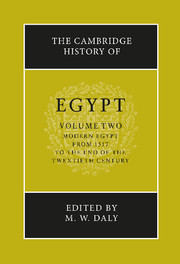Book contents
- Frontmatter
- 1 Ottoman Egypt, 1525–1609
- 2 Egypt in the seventeenth century
- 3 Egypt in the eighteenth century
- 4 Culture in Ottoman Egypt
- 5 The French occupation of Egypt, 1798–1801
- 6 The era of Muhammad ’Ali Pasha, 1805–1848
- 7 Egypt under the successors of Muhammad ’Ali
- 8 The Egyptian empire, 1805–1885
- 9 The ‘Urabi revolution and the British conquest, 1879–1882
- 10 The British occupation, 1882–1922
- 11 Social and economic change in the “long nineteenth century”
- 12 The liberal age, 1923–1952
- 13 Egypt: society and economy, 1923–1952
- 14 Republican Egypt interpreted: revolution and beyond
- 15 Modern Egyptian culture in the Arab world
- Select Bibliography
- Index
- References
4 - Culture in Ottoman Egypt
Published online by Cambridge University Press: 28 March 2008
- Frontmatter
- 1 Ottoman Egypt, 1525–1609
- 2 Egypt in the seventeenth century
- 3 Egypt in the eighteenth century
- 4 Culture in Ottoman Egypt
- 5 The French occupation of Egypt, 1798–1801
- 6 The era of Muhammad ’Ali Pasha, 1805–1848
- 7 Egypt under the successors of Muhammad ’Ali
- 8 The Egyptian empire, 1805–1885
- 9 The ‘Urabi revolution and the British conquest, 1879–1882
- 10 The British occupation, 1882–1922
- 11 Social and economic change in the “long nineteenth century”
- 12 The liberal age, 1923–1952
- 13 Egypt: society and economy, 1923–1952
- 14 Republican Egypt interpreted: revolution and beyond
- 15 Modern Egyptian culture in the Arab world
- Select Bibliography
- Index
- References
Summary
States and elites
The culture of the Ottoman period has often been analyzed by using the same criteria applied to the periods before and after it, Mamluk Egypt (1250–1517) and the nineteenth century. This is problematic for two reasons, firstly because of the very different roles played by the state in relation to culture and learning and secondly because of the role of elites in providing models and patterns of culture. The influence of the ruling class in shaping culture can change between one period and another, and can be greater at certain times than at others. When the state is centralized, the ruling class is much more likely to play a dominant role than it is in a decentralized state. The cultural production is more likely to be polished and refined when ruling classes dominate the direction that it takes, and less so when their role is reduced. When the state is decentralized, as it was during the Ottoman period, and the structures at the top are weaker, the cultural forms and patterns from below are more likely to emerge. Therefore, rather than compare this period to those before or after it, we may approach it through the larger framework of its changing social and political structures.
In both Mamluk Egypt and Egypt under the rule of Muhammad ’Ali and his descendants (nineteenth century), the state was very centralized and played an active role in financing and shaping culture and in education. Likewise the ruling elites were actively involved in creating cultural models.
- Type
- Chapter
- Information
- The Cambridge History of Egypt , pp. 87 - 112Publisher: Cambridge University PressPrint publication year: 1998



